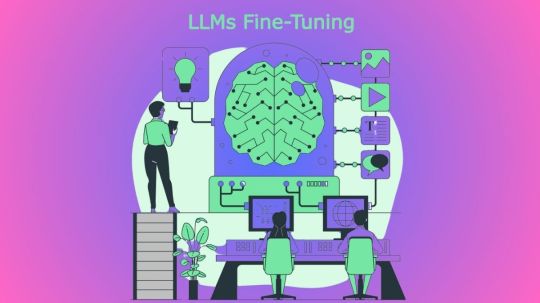#GenAIapplications
Explore tagged Tumblr posts
Text
Top 5 Fine Tuning LLM Techniques & Inference To Improve AI

Fine Tuning LLM Techniques
The Top 5 Fine Tuning LLM Techniques and Inference Tricks to Boost Your AI Proficiency. With LLM inference and fine-tuning, your generative AI (GenAI) systems will perform even better.
The foundation of GenAI is LLMs, which allow us to create strong, cutting-edge applications. But like any cutting-edge technology, there are obstacles to overcome before they can be fully used. It may be difficult to install and fine-tune these models for inference. You may overcome these obstacles with the help of these five recommendations from this article.
Prepare Your Data Carefully
The performance of the model is largely dependent on efficient data preparation. Having a clean and well-labeled dataset may greatly improve training results. Noisy data, unbalanced classes, task-specific formatting, and nonstandard datatypes are among the difficulties.
Tips
The columns and structure of your dataset will depend on whether you want to train and fine-tune for teaching, conversation, or open-ended text creation.
Generate fake data from a much bigger LLM to supplement your data. To create data for fine-tuning a smaller 1B parameter model, for instance, utilize a 70B parameter model.
” This still holds true for language models, and it may significantly affect your models’ quality and hallucination. Try assessing 10% of your data by hand at random.
Adjust Hyperparameters Methodically
Optimizing hyperparameters is essential to attaining peak performance. Because of the large search space, choosing the appropriate learning rate, batch size, and number of epochs may be challenging. It’s difficult to automate this using LLMs, and optimizing it usually involves having access to two or more accelerators.
Tips
Utilize random or grid search techniques to investigate the hyperparameter space.
Create a bespoke benchmark for distinct LLM tasks by synthesizing or manually constructing a smaller group of data based on your dataset. As an alternative, make use of common benchmarks from harnesses for language modeling such as EleutherAI Language Model Evaluation Harness.
To prevent either overfitting or underfitting, pay strict attention to training data. Look for circumstances in which your validation loss rises while your training loss stays constant this is a blatant indication of overfitting.
LLM Fine tuning Methods
Employ Cutting-Edge Methods
Training time and memory may be greatly decreased by using sophisticated methods like parameter-efficient fine-tuning (PEFT), distributed training, and mixed precision. The research and production teams working on GenAI applications find these strategies useful and use them.
Tips
For accuracy to be maintained across mixed and non-mixed precision model training sessions, verify your model’s performance on a regular basis.
To make implementation simpler, use libraries that enable mixed precision natively. Above all, PyTorch allows for automated mixed precision with little modifications to the training code.
Model sharding is a more sophisticated and resource-efficient approach than conventional distributed parallel data approaches. It divides the data and the model across many processors. Software alternatives that are popular include Microsoft DeepSpeed ZeRO and PyTorch Fully Sharded Data Parallel (FSDP).
Low-rank adaptations (LoRA), one of the PEFT approaches, let you build “mini-models” or adapters for different tasks and domains. Additionally, LoRA lowers the overall number of trainable parameters, which lowers the fine-tuning process’s memory and computational cost. By effectively deploying these adapters, you may handle a multitude of use scenarios without requiring several huge model files.
Aim for Inference Speed Optimization
Minimizing inference latency is essential for successfully deploying LLMs, but it may be difficult because of their complexity and scale. The user experience and system latency are most directly impacted by this component of AI
Tips
To compress models to 16-bit and 8-bit representations, use methods such as low-bit quantization.
As you try quantization recipes with lower precisions, be sure to periodically assess the model’s performance to ensure accuracy is maintained.
To lessen the computational burden, remove unnecessary weights using pruning procedures.
To build a quicker, smaller model that closely resembles the original, think about model distillation.
Large-Scale Implementation with Sturdy Infrastructure
Maintaining low latency, fault tolerance, and load balancing are some of the issues associated with large-scale LLM deployment. Setting up infrastructure effectively is essential.
Tips
To build consistent LLM inference environment deployments, use Docker software. The management of dependencies and settings across several deployment phases is facilitated by this.
Utilize AI and machine learning tools like Ray or container management systems like Kubernetes to coordinate the deployment of many model instances within a data center cluster.
When language models get unusually high or low request volumes, use autoscaling to manage fluctuating loads and preserve performance during peak demand. In addition to ensuring that the deployment appropriately satisfies the application’s business needs, this may assist reduce money.
While fine-tuning and implementing LLMs may seem like difficult tasks, you may overcome any obstacles by using the appropriate techniques. Overcoming typical mistakes may be greatly aided by the advice and techniques shown above.
Hugging Face fine-tuning LLM
Library of Resources
For aspiring and experienced AI engineers, it provide carefully crafted and written material on LLM fine-tuning and inference in this area. They go over methods and tools such as Hugging Face for the Optimum for Intel Gaudi library, distributed training, LoRA fine-tuning of Llama 7B, and more.
What you will discover
Apply LoRA PEFT to cutting-edge models.
Find ways to train and execute inference with LLMs using Hugging Face tools.
Seek to use distributed training methods, such as PyTorch FSDP, to expedite the process of training models.
On the Intel Tiber Developer Cloud, configure an Intel Gaudi processor node.
Read more on govindhtech.com
#Top5#ImproveAI#TuningLLMTechniques#IntelGaudi#generativeAI#languagemodels#GenAIapplications#machinelearning#IntelTiberDeveloperCloud#SturdyInfrastructure#DataCarefully#technology#technews#news#govindhtech
0 notes
Text
H2O.ai Recognized On The First-Ever CRN AI 100 List

H2O.ai, a top company in open-source Generative AI and machine learning, has received recognition from CRN®, a brand of The Channel Company. They have been included in the prestigious 2024 AI 100 list in the AI For Cloud category. This list showcases vendors who are leading the way in the AI revolution, offering solutions in cloud computing, data centers, edge computing, software, analytics, and cybersecurity. Being featured on this list highlights H2O.ai's commitment to innovation and their crucial role in helping IT channel partners develop groundbreaking AI technologies and solutions.
The AI 100 list holds great significance in today's IT market, as solution providers are increasingly investing in AI portfolios to drive growth and seize opportunities in 2024 and beyond. The vendors selected for this list were carefully chosen by a panel of CRN editors based on the strength of their AI offerings, their dedication to innovation, and their ability to support IT channel partners in implementing AI solutions.
Sri Ambati, the CEO and Founder of H2O.ai, expressed his pride in the company's inclusion on the AI 100 list. He emphasized H2O.ai's mission to push the boundaries of Generative AI and machine learning and their commitment to working closely with partners to create valuable AI applications that boost productivity and drive success. Ambati's remarks demonstrate H2O.ai's dedication to empowering the IT channel with advanced AI solutions.
Jennifer Follett, the VP of U.S. Content and Executive Editor at CRN, recognized the efforts of the honorees in advancing AI solutions within the IT channel. She highlighted that each company on the AI 100 list earned their spot by actively assisting channel partners in building transformative AI solutions that lead to customer success. Follett's statement underscores the importance of these vendors in fostering excellence in AI within the channel.
Read More - https://www.techdogs.com/tech-news/business-wire/h2oai-recognized-on-the-first-ever-crn-ai-100-list
0 notes